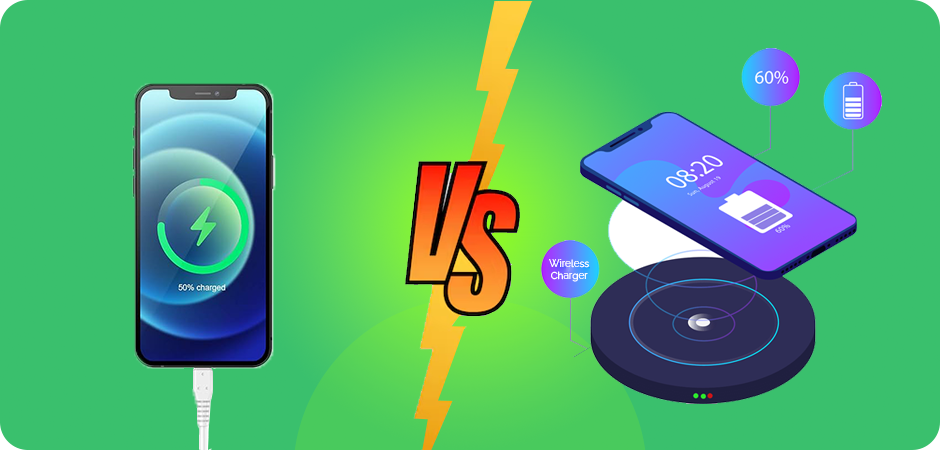7 Wireless Charging vs Wired Charging: What’s the difference?

Have you ever heard about the Wireless charger that has gained so much popularity in the world last almost 15 years Bart many people don’t know about the wireless chargers that have become the part of market nowadays. This is the latest technology that has been introduced in the world. Wireless charges are becoming the trend on social media as they want to make it popular like the wired charger. In this blog, we will explore new facts and interesting things that you didn’t know before about wireless charging vs wired charging, without wasting time. Let’s get into: Necessity Guide About 7 Wireless Charging vs Wired Charging What Is Wireless Charging? With wireless charging, there is no longer a need for wires or connectors to charge electronics, which is a huge benefit. Your smartphone, earphones, or other compatible gadget will start to charge when you place it on a wireless charging pad or stand. The electromagnetic induction concept is the secret behind wireless charging’s enchantment. An electromagnetic field is created around the wireless charger by energy passing through a transmitter coil. This field creates an electric current in a receiver coil within your compatible gadget when you place it on the charger, charging the battery. Different brands and kinds of wireless chargers use different standards, thus not all devices can be used with them. Qi (pronounced “chee”), created by the Wireless Power Consortium (WPC) and authorized by the majority of significant smartphone manufacturers, is the most widely used wireless charging standard. It will be simpler for you to switch to wireless charging thanks to this standard, which guarantees compatibility with a wide variety of gadgets and chargers. What is Qi Inductive Wireless Charging? The Wireless Power Consortium is developing Qi, which is derived from the Chinese word qi, an open interface standard that defines wireless power transfer via inductive charging over distances of up to 4 cm (1.6 inches). In essence, electromagnetic fields are used in wireless charging, also known as wireless power transfer, to safely transfer electricity from a transmitting source to a receiving device to charge or recharge a battery. Furthermore, it accomplishes this without requiring a physical connection, as the name implies. Easy, effective, and secure, Numerous devices are powered or charged by qi. Cellphones, cordless kitchen appliances, and other items fall under this category. Qi delivers an exceptional standard by utilizing both resonance and induction technologies. What Is Wired Charging? The usual method that has been powering our devices for decades is wired charging. It’s the simple procedure that we’re all familiar with: you take a cable, insert one end into the USB port on your device, and the other end into the charging port on your device, and boom! Your gadget begins to charge. The direct electrical connection that cable charging creates between the gadget and the power source is its fundamental component. Fast and constant power transfer is made possible by this physical connection, guaranteeing that gadgets are fully charged and operational. Compatibility with a large variety of devices is provided by wired charging, including computers, cameras, tablets, and smartphones. It is dependent on common standards like USB, which includes USB-C, micro-USB, and Lightning ports for Apple devices. Wireless Charging vs Wired: Which Is Better? With the growing number of times we use our electronics for work and play, the effectiveness and practicality of charging solutions have become essential. Wireless charging competes with the conventional, tried-and-true dependability of wired charging due to its increasing popularity and the draw of a cable-free experience. So, the question that now has to be answered is: which pricing method is best for you? This tutorial examines the differences between the two charging techniques, weighing the benefits and drawbacks of wireless charging vs wired charging to give you the information you need to choose the one that best suits your digital lifestyle. Now let’s get started! Wireless vs Wired Charging: Which is Better for Battery Life? To begin with, any type of battery charging wears it out. External variables such as heat can increase this year, lowering the battery’s capacity over time. And this is where wireless charging falls short of traditional wired charging methods. While charging, not all of the electricity drawn from a wall socket makes it to your device’s battery. Wireless charging is usually believed to be approximately 80% efficient. In practice, this figure could dip as low as 50%, depending on how well the coils in the charger and smartphone are aligned. Needless to say, cable charging is significantly more efficient because a copper line carries electricity exceptionally well and has no physical gaps. We evaluated 100W wired and wireless Charging to validate this hypothesis in the real world. Coming back to wireless charging, any energy that does not reach your device is turned into heat. And, as previously said, repeated exposure to heat will harm your device’s battery. Furthermore, using a thick case on your smartphone may hinder it from cooling down rapidly enough. Factors to Consider in Choosing Between Wireless vs Wired Charging There are several important considerations when choosing between wireless charging vs wired charging, and each one has a unique impact on how well you charge. Here’s a closer examination of each of these factors: Charging Speed Because there is a direct connection between the device and the power source, wired charging allows for higher charging speeds. This is especially true for USB-C and Qualcomm Quick Charge technologies, which may substantially cut down on the amount of time required for compatible devices to charge. However, compared to wired options, wireless charging is typically slower. Longer periods to get a full charge are caused by basic efficiency losses in the wireless charging method, particularly inductive charging. Though improvements are being made, and some recent models provide faster wireless charging, these usually fall short of the fastest wired options. Convenience With wired charging, a physical cable connection between your device and the charger is required. This may not always be as easy, particularly if you move your smartphone around a
